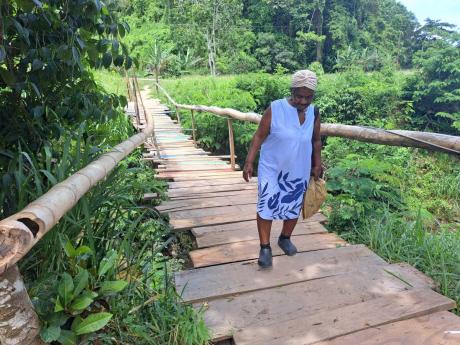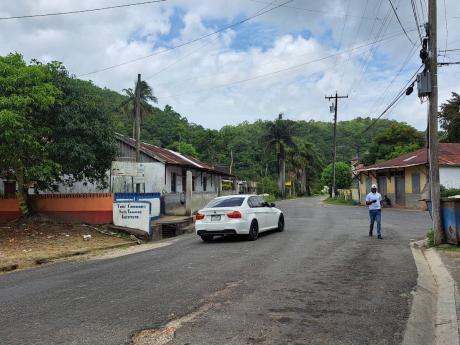‘Troy is still suffering’
Bridge woes persist three years after collapse
WESTERN BUREAU:
Nearly three years after the collapse of the Troy bridge in Trelawny, residents, businesses and commuters are still grappling with the hardships caused by the absence of the vital artery.
The century-and-a-half-year-old structure collapsed in August 2021 during the passage of Tropical Storm Grace, leaving a profound void in the lives of residents straddling the parishes of Trelawny, Manchester, and St Elizabeth.
Despite makeshift solutions and promises of reconstruction, locals express frustration and concern over the prolonged wait to restore this essential lifeline.
“We want the bridge, y’know. Everybody, from a pin to an anchor, we want the bridge,” Andre Plummer, a resident of Cowick Park in Manchester, told The Sunday Gleaner last week, summing up the sentiment of those affected on either side of Hectors River, the width of which the 152-year-old bridge spanned.
The severe disconnect being felt by people who have to go to work and school between the three parishes is evidenced by a noticeable lack of traffic through Troy even on a weekday morning.
Residents have noted that the bridge’s absence has resulted in Manchester students, who attended school in Troy, being transferred to different schools. Patients who crossed the border to access care at the Troy Health Centre now have to go to Balaclava in St Elizabeth, and at least one business has shut its doors.
Plummer, a bike-taxi operator, told The Sunday Gleaner that at present, he and other residents on both sides have to use a makeshift wooden bridge a few metres away from the collapsed structure.
“You see the one bridge we have right now, it’s a good help to everybody. Right now, if the river comes down, we can cross on top of it, but if the river comes down and passes over it, we can’t cross,” he explained. “The authorities did put up a sign over there saying nobody nuh fi use it, the small bridge. But which part we fi cross? Where we woulda walk, down inna di river same way? You have to think about everybody.”
The wooden bridge consists of several planks strategically placed atop two fallen trees stretching across the river. It is the latest one installed after another built last year had to be replaced as its integrity was compromised.
While residents traverse the bridge by foot and on motorcycles alike, there is always a sense of unease, although it is an improvement over a pulley-and-bucket mechanism that they previously relied on to shuttle people and goods across the river.
Pauline Brown, principal of the Clarence Brimm Basic School in Troy, lamented that the makeshift bridge has done little to ease the fears of students, including those who attend the neighbouring Troy High and Troy Primary schools.
“The community is still suffering, and it is badly in need of the Troy bridge. We continue to have people from the other side being marooned from this side for a long time now, and we still have the problem that whenever it rains, the [distance between the riverbanks] is widened and getting worse. Even though they have a little makeshift bridge down there, I went down there to look at it and I am afraid of it, and I am afraid for the children,” said Brown, whose school has 64 students on roll.
“As to our school’s population, we used to get 20 to 30 students from that side coming over here, and we don’t have that anymore. Even though the makeshift bridge is there, it is very slippery, and people are just afraid to send them across the bridge.”
Southern Trelawny remains without a member of parliament following the resignation of Marisa Dalrymple Philibert nearly a year ago.
Falmouth Mayor Collen Gager, who is the councillor for the Warsop Division in which Troy is located, acknowledged that signs had previously been erected warning citizens not to use the makeshift bridge due to safety concerns.
“The Troy bridge’s absence weighs heavily on us because it cuts off that traffic that comes from Cowick Park [in Manchester] going to Santa Cruz and Black River [both in St Elizabeth], that would usually pass through Troy. It presents a difficult time for people who want to use it, so they have to be moving across on a makeshift bridge, which is very dangerous,” said Gager, who himself is a farmer and resident of Troy.
The absence of the bridge is also placing a burden on the residents finances as they pay increased fares and gas costs to get to their destinations.
Additionally, journeys which would usually take minutes between Trelawny and Manchester now take, at minimum, an additional hour and a half as commuters must take longer detours and use multiple public vehicles.
For Icylin Robinson, an elderly resident of Cowick Park, the bridge’s collapse has made life harder for her since she has a sickly husband and also has to conduct her own business in Trelawny.
“They said we would get back the bridge last year, and every time dem say we a go get it back, we nuh get it. If anybody sick, we inna problem to come to Troy, and mi come on this side to go church and go do my little business,” Robinson groused, referencing a previous promise from the Government in August 2022 that work on the bridge would commence during the 2022-2023 fiscal year.
“Whoever is from Balaclava comes and drops off passengers and turns back, and who comes from Christiana [in Manchester] will come here so and drop off, and if di people can go cross, dem go cross,” Robinson outlined. “It is years now, and people a suffer. Mi have fi mi husband who is sick, and mi haffi pray, ‘God, nuh mek no sickness come inna night’, because when you call the Balaclava taxi dem, you nah get dem quick.”
Some $169 million has been allocated in this year’s Budget to replace the bridge, with the project to be manned by the National Works Agency (NWA) and expected to be halfway completed by March 2025. It is also expected that the single-lane structure will be replaced by a two-lane bridge with pedestrian sidewalks and signage.
Janel Ricketts, the NWA’s western regional community relations officer, told The Sunday Gleaner that an official announcement regarding the works is to be made soon.
“We went through the contract tendering process, and the contract has been awarded, so we’re just in the final stages of tying up the process of the contract formulation in terms of all the legalities with submissions and so on. Once everything is finalised, we will make an announcement as to the contractor and the contract details and so on,” said Ricketts.
While welcoming the upcoming move to begin working on the new structure, Manchester North Western Member of Parliament Mikael Phillips is disappointed with the length of time it has taken to begin, noting the impact on both sides.
“You have farmers on the Manchester side that would go to Christiana or Spaldings to ply their wares, and it would be much easier for them transportation wise; and even on the Trelawny side of the bridge, a part of Manchester North Western is [accessed] on that side. I have to pass through Troy to go to Golden Run, which is Manchester North Western,” said Phillips.
“You have farmers on that side who would normally go even as far as Savanna-la-Mar Market in Westmoreland, and to Santa Cruz and Black River in St Elizabeth, who no longer go to those markets because of the additional distance that they would have to traverse. So it has affected the farmers, and you have farmers from the Trelawny side that would normally go to the South Coast who would drive that way,” Phillips continued.
“It was a thoroughfare that tourists would use coming from the North Coast, driving through the hills to go to Appleton or the South Coast. It has impacted farming, tourism, and just the daily lives of those who live on the Manchester and Trelawny sides.”



